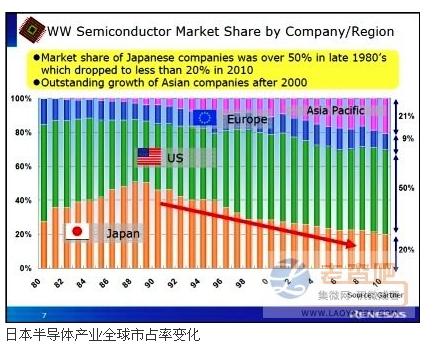 At the International Electronics Forum in Europe, Junshi (JJ) Yamaguchi, former chairman of Renesas Electronics, said that the Japanese semiconductor industry, which has been declining for more than 20 years, needs to re-select key technology areas and Focus on re-emergence.
At the International Electronics Forum in Europe, Junshi (JJ) Yamaguchi, former chairman of Renesas Electronics, said that the Japanese semiconductor industry, which has been declining for more than 20 years, needs to re-select key technology areas and Focus on re-emergence. Yamaguchi, who is currently a special adviser to Renesas and the Japan Semiconductor Industry Association, pointed out that the 311 Great Earthquake and Tsunami in Japan has not proved to be a turning point for the Japanese and the local wafer manufacturers. In his speech, he presented a picture of the change in the global market share of the Japanese wafer industry, which was 51% in 1988, 44% by 1994, and further reduced to 29% by 1998, leaving only 20 in 2010. %.
Yamaguchi also explained the main reasons for the above recession. In the 1970s, Japan decided to invest in DRAM production. In 1980, sales growth of personal computers drove demand for DRAM, and Japanese wafer manufacturers enjoyed significant growth in product shipments and revenue. However, the political intervention of the United States has brought a turning point. Japan and the United States and in 1988 signed a U.S.-Japan Semiconductor Agreement. According to the agreement, Japan must not sell at a cost below cost. In DRAM, the U.S. supplier’s market share in the Japanese wafer market also increased from 10% to 20%.
“The restrictions on capital expenditures and imports from Japanese semiconductor companies have led to the rise of Korea (in the DRAM and semiconductor markets); “Yamaguchi said that Japan’s attitude has been too conservative and its problems are largely excluded from the DRAM market. , And focusing on ASIC production too long and continued: "In 2000, SoC's business opportunities had been very strong, but the ASSP components, not ASIC components." The foundry industry was also rapidly growing.
"Japan needs reform;" Yamaguchi said he also saw signs of some manufacturers' attitudes beginning to change, that is, after the 311 earthquake: "Renesas's unbelievable achievement in three months to restore production was not originally expected. 6 to 9 months," he said. This means that when people come together and sacrifice holidays, they can accomplish their goals.
Yamaguchi believes that Japanese manufacturers still occupy leading positions in some areas, so the country’s manufacturers should focus on the development of microcontrollers, NAND flash memory, CMOS sensors and other products. Since the main driving force of the current global economic growth comes from neighboring Asian countries, Japan has a very good position to compete with other countries in applications requiring hardware and software solutions, such as mobile consumer electronics devices, sustainable energy, and medical care. Care and security, etc.
"Although we had many problems in the past, we now know where to go!" Yamaguchi concluded.
In this Luxury Electric Blanket, there are Soft fleece Electric Blanket, Bejirog material electric blanket, comfort and safety, energy saving and environmental protection, luxurious colours and assembly with the latest features, it's just the thing for those cold evenings when you want to settle down in warm bed for the night.
Soft Fleece Luxury Electric Blanket
Soft Fleece Luxury Electric Blanket,Fleece Luxury Electric Blanket,Soft Luxury Electric Blanket,Washable Soft Fleece Electric Blanket
SHIJIAZHUANG BEIJIREN ELECTRIC APPLIANCE CO., LTD. , http://www.beijirenelectricblanket.com